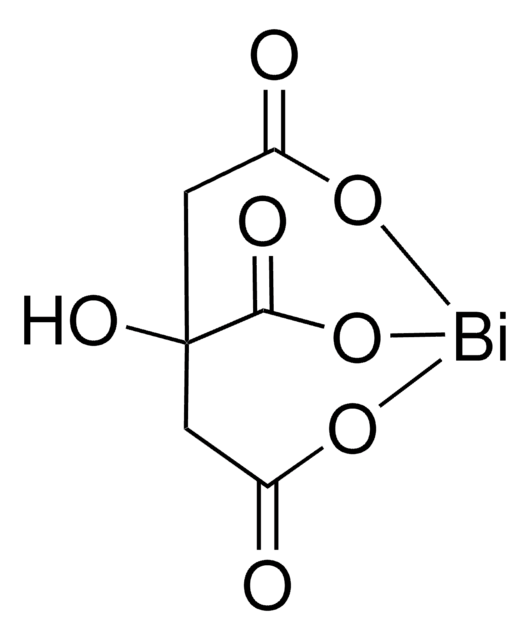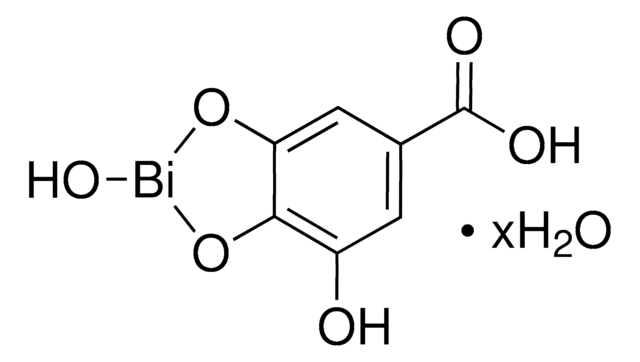401587
Bismuth(III) acetate
≥99.99% trace metals basis
Synonym(s):
Bismuth triacetate, Acetic acid bismuth(III) salt
Sign Into View Organizational & Contract Pricing
All Photos(2)
About This Item
Linear Formula:
(CH3CO2)3Bi
CAS Number:
Molecular Weight:
386.11
MDL number:
UNSPSC Code:
12161600
PubChem Substance ID:
NACRES:
NA.22
Recommended Products
Quality Level
Assay
≥99.99% trace metals basis
form
solid
reaction suitability
core: bismuth
reagent type: catalyst
impurities
≤5% Bi2O3
SMILES string
CC(=O)O[Bi](OC(C)=O)OC(C)=O
InChI
1S/3C2H4O2.Bi/c3*1-2(3)4;/h3*1H3,(H,3,4);/q;;;+3/p-3
InChI key
WKLWZEWIYUTZNJ-UHFFFAOYSA-K
Application
- Bismuth(III) acetate is employed as a starting material in the synthesis of bismuth(III) sulfide (Bi2S3) which can be used in solution-processable bulk heterojunction solar cells.
- It is used in the preparation of gold-bismuth sulfide (Au–Bi2S3) heteronanostructures and bismuth titanate nanorods as photocatalysts.
- It is also used in the synthesis of triarylbismuth compounds.
Storage Class Code
11 - Combustible Solids
WGK
WGK 3
Flash Point(F)
Not applicable
Flash Point(C)
Not applicable
Choose from one of the most recent versions:
Certificates of Analysis (COA)
Lot/Batch Number
Don't see the Right Version?
If you require a particular version, you can look up a specific certificate by the Lot or Batch number.
Already Own This Product?
Find documentation for the products that you have recently purchased in the Document Library.
Customers Also Viewed
Photocatalytic Au-Bi2S3 Heteronanostructures.
Manna G, et al.
Angewandte Chemie (International Edition in English), 53(26), 6743-6746 (2014)
Bismuth titanate nanorods and their visible light photocatalytic properties.
Pei LZ, et al.
J. Alloy Compounds, 622(26), 254-261 (2015)
M Makrinich et al.
Solid state nuclear magnetic resonance, 92, 19-24 (2018-05-12)
Dipolar recoupling under magic-angle spinning allows to measure accurate inter-nuclear distances provided that the two interacting spins can be efficiently and uniformly excited. Alexander (Lex) Vega has shown that adiabatic transfers of populations in quadrupolar spins during the application of
Crystal splitting in the growth of Bi2S3.
Tang J and Alivisatos AP
Nano Letters, 6(12), 2701-2706 (2006)
Hybrid solution-processed bulk heterojunction solar cells based on bismuth sulfide nanocrystals.
Martinez L, et al.
Physical Chemistry Chemical Physics, 15(15), 5482-5487 (2013)
Our team of scientists has experience in all areas of research including Life Science, Material Science, Chemical Synthesis, Chromatography, Analytical and many others.
Contact Technical Service










